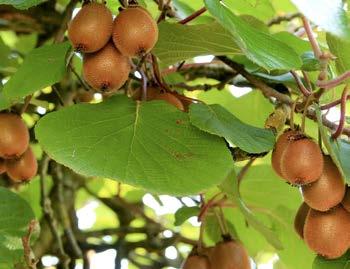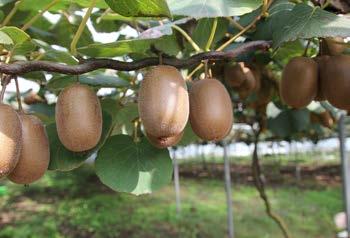
4 minute read
Fruit produ c tion part2 : KIWI FRUIT
from ProAgri Zambia 85
by ProAgri
by Maryna Steyn
Kiwi fruit production has been a hot topic for over two years. Many growers have seized the opportunity to farm with kiwis and capitalise on the demand for this exotic fruit.
Advertisement
Contrary to popular belief, these fruits do not originate from New Zealand, but rather China. Commercial production, however, took off in New Zealand during the early 1960s when seed was taken there. Kiwi fruit, kiwis, or kiwi fruit, are names given for market appeal (by an American woman no less), but it was first known as the Chinese gooseberry, botanically named Actinidia deliciosa — delicious indeed!
The hairy brown egg-shaped fruit is a sought-after ingredient or snack. Fruits are consumed after peeling, either by enjoying slices or adding it to salads, smoothies, deserts or juices.
The inside is a light green with a white centre. The small black seeds are tightly grouped around the centre. Kiwis are full of vitamin C, almost twice the quantity of oranges! The juicy inside can taste acidic, but the riper the fruit, the sweeter it tastes.

Positive dietary impacts lead to the rise in kiwi fruit cultivation. These health benefits include eye-health due to the Zeaxanthin and Lutein compounds in the fruit. The high vitamin C content is an immune booster as well as anti-inflammatory and antioxidant. It also has a high fibre content which improves digestion with the added benefit of the substance Acanidin which breaks down protein.
Growing kiwis commercially is expensive. To produce fruits, the plant first needs to mature. In theory this can be three years, but it takes up to five years to have a full harvest.
The infrastructure required is also expensive to build. The trellis the vines use to grow on needs to be almost two metres high and strong enough to support the 5 metre vines and its hundreds of fruits.
To be a grower, you need to register and pay royalties to be a commercial grower in some countries such as South Africa.
It is also necessary to ensure that there is an optimal ratio of male to female plants to promote pollination. One male plant for every nine female plants. Only the female plants bear fruit, and pollination can be tricky since the female plants do not have nectar. Placing beehives between the vines can assist with this.
What makes it so lucrative is that it is a high-value crop that you can grow on a relatively small scale. A single vine can produce hundreds of fruits which means the output is beneficial.
Soil and climatic requirements
Kiwi plants require fertile, well-draining soil. The soil needs to be moist and moisture retentive, while also being aerated. Too much water can cause root rot.
Soil drainage can be improved by mixing compost into the soil. It will also benefit the plant by providing nutrients.
Kiwis prefer slightly acidic to neutral soil, meaning a pH between 5,5 and 7,5.

Ideal temperatures range from 5 to 25 °C. The plant can tolerate low temperatures, but it does not do well with frost, especially the flowers and the trunk. High temperatures can burn the fruit.
Netting can be used as a cover to protect against frost.
Planting
It is not recommended to commercially grow kiwi fruit from seeds. Instead, use grafted plants and ask your local nursery which varieties they have available.



Dig a large hole and plant the plant the same depth as it was grown in the nursery. The hole should be wider than it is deep because kiwi plants have shallow roots. Avoid root bounding by pulling them slightly apart before planting.
Fertilisation
Fertilise with rock phosphate and kelp meal before closing the hole.
Kiwi fruit is eaten on its own or as a delicious ingredient in smoothies, salads or other fresh dishes.
(Source: Nicola Barts on Pexels) metres apart. Connect them with a crossbeam at the top. Rows of beams can continue as long as your space allows, but two more support poles with crossbeams should be planted every metre.
From crossbeam to crossbeam, the length of the row, 12-guage wire can be run 0,3 metres apart. This creates ideal support for heavy female plants,
Tie the vines to the trellis to keep them from drooping to the ground.
If you use nets to protect the crop from frost, they need to be at least 4,8 metres high, or 5,3 metres at most. The net needs to offer 20% shade.
Pruning is important to manage the weight and promote growth. Cut off any side shoots to force upward growth. When the top growth is dormant (not growing), head it. Cut off canes that grew but did not bear fruit after the first fruiting season.
Any other weak, damaged, broken or unhealthy canes should also be pruned.
Prune vines before spring when new growth starts, rather prune in autumn or winter.
Fruit is harvested when it starts to change colour.
Set up an annual fertiliser schedule. Every spring, spread fertiliser throughout the orchard to feed the shallow roots. Ensure the fertiliser you use is high in nutrients, especially nitrogen.
Irrigation
As soon as your kiwi is planted, irrigate it immediately.
Kiwis require high rainfall of approximately 800 to 1 000 mm per year.
Irrigate the crop once or twice a week in summer, but less in winter. You can irrigate the crop whenever the topsoil seems dry.
Applying mulch on a regular basis can help retain moisture and also reduce weeds.
Trellis construction and pruning
Trellis should be 1,9 metres high. It is recommended that strong poles and crossbeams are used.
For every row, plant two poles 1, 5
Left: The skin of the kiwi is brown and hairy. (Source: Peter de Vink on Pexels)
Right: The inside of the fruit is light green with a white centre. The black seeds are closely grouped around the centre. (Source: Photomix on Pexels)

References
Climatic requirements - KZNDARD. GOV.ZA. 2006. Available: https:// www.kzndard.gov.za/images/Documents/Horticulture/Veg_prod/climatic_requirements.pdf
Farming with kiwis: All you need to know. 2022. Available: https://www. foodformzansi.co.za/farming-withkiwis-all-you-need-to-know/3/
One
Kiwi fruit: Fruit: Grow to eat. 2020. Available: https://www.thegardener. co.za/grow-to-eat/diy-food/kiwi-fruit










